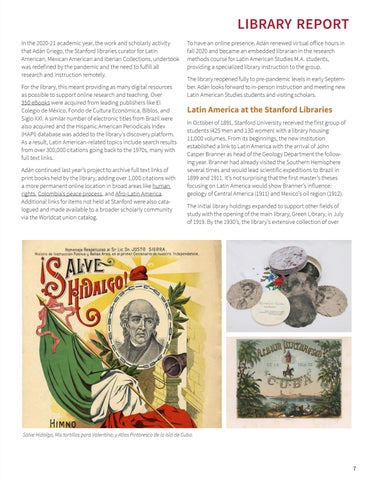LIBRARY REPORT In the 2020-21 academic year, the work and scholarly activity that Adán Griego, the Stanford libraries curator for Latin American, Mexican American and Iberian Collections, undertook was redefined by the pandemic and the need to fulfill all research and instruction remotely. For the library, this meant providing as many digital resources as possible to support online research and teaching. Over 350 eBooks were acquired from leading publishers like El Colegio de México, Fondo de Cultura Económica, Biblos, and Siglo XXI. A similar number of electronic titles from Brazil were also acquired and the Hispanic American Periodicals Index (HAPI) database was added to the library’s discovery platform. As a result, Latin American-related topics include search results from over 300,000 citations going back to the 1970s, many with full text links. Adán continued last year’s project to archive full text links of print books held by the library, adding over 1,000 citations with a more permanent online location in broad areas like human rights, Colombia’s peace process, and Afro-Latin America. Additional links for items not held at Stanford were also catalogued and made available to a broader scholarly community via the Worldcat union catalog.
To have an online presence, Adán renewed virtual office hours in fall 2020 and became an embedded librarian in the research methods course for Latin American Studies M.A. students, providing a specialized library instruction to the group. The library reopened fully to pre-pandemic levels in early September. Adán looks forward to in-person instruction and meeting new Latin American Studies students and visiting scholars.
Latin America at the Stanford Libraries In October of 1891, Stanford University received the first group of students (425 men and 130 women) with a library housing 11,000 volumes. From its beginnings, the new institution established a link to Latin America with the arrival of John Casper Branner as head of the Geology Department the following year. Branner had already visited the Southern Hemisphere several times and would lead scientific expeditions to Brazil in 1899 and 1911. It’s not surprising that the first master’s theses focusing on Latin America would show Branner’s influence: geology of Central America (1911) and Mexico’s oil region (1912). The initial library holdings expanded to support other fields of study with the opening of the main library, Green Library, in July of 1919. By the 1930’s, the library’s extensive collection of over
Salve Hidalgo, Mis tortillas para Valentina, y Atlas Pintoresco de la Isla de Cuba.
7




